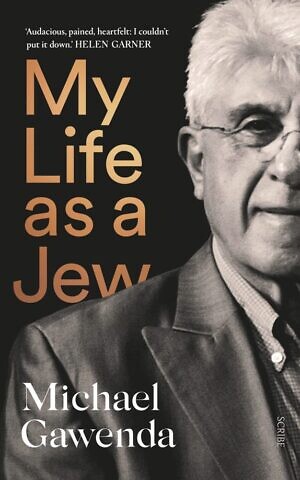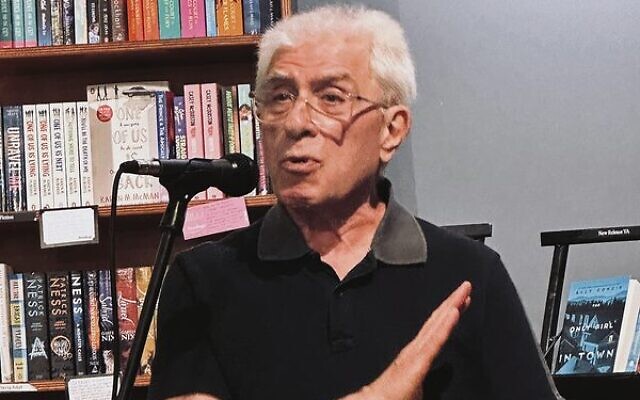Michael Gawenda’s Jewish journey
In his new autobiography My Life As A Jew, Michael Gawenda writes how the left, in which he once felt kinship, increasingly came to demonise Israel.
THE launch in Melbourne of journalist Michael Gawenda’s autobiography My Life As A Jew now seems from another era – two days before the Hamas massacres in Israel.
It was a warm-hearted gathering at Readings bookshop in St Kilda’s storied Acland Street, more simcha than book launch, with Yiddish songs from the Bashevis Singers, a Gawenda family band.
The author paid tribute to his family, especially to his sister Tasha, 93, who escaped with other family members from their pre-war home in Lodz to Russia and a labour camp, then a postwar DP camp. Gawenda was born there in 1947. Tasha and the family later emigrated to Australia. “She’s led a mighty life,” he said.
The triple Walkley Award winner wrote for The AJN in the 1980s, was a senior editor of Time, editor-in-chief of The Age – the only Jewish journalist to occupy that role – and Fairfax’s Washington correspondent. He was inaugural director of the University of Melbourne’s Centre for Advancing Journalism.
In My Life As A Jew, Gawenda, a self-described Jew of the left, invites readers to travel with him on an ideological journey from his Shoah-impacted Bundist family heritage and a Melbourne childhood in SKIF, through a career in which his Jewish identity somewhat informed but didn’t define his journalism. We arrive with Gawenda at life’s autumn, where he sees himself embracing an engaged Jewish lifestyle as a reflective, even doting grandfather.
Along the way, there were the tribulations of becoming “a public Jew” – his surprise at the degree to which colleagues and readers attributed his editorial decisions on Middle East coverage in The Age to the editor’s Jewish identity. That happened most starkly in 2002, when he decided not to publish a Michael Leunig cartoon on the Palestinians which equated Israelis with Nazis. In parallel, sections of the Jewish community raised his Jewishness when they attacked the paper’s Israel coverage.

My Life As A Jew opens with a raw account of how he ended a long friendship with Jewish publisher Louise Adler. In 2021, Adler included an article by journalist John Lyons about Australian media and the “Israel lobby” in a series for Monash University Publishing. Gawenda and Adler fell out after she defended publishing Lyons’ assertion that media are cowed by Israel activists. He insisted it was thinly researched and unfair. And he was saddened at her signing a 2021 journalists’ open letter urging a more pro-Palestinian emphasis.
Much of what follows is about Gawenda’s ideological churn. He laments the crocodile tears cried by the left for Shoah victims, and its attempts to “de-Jewify” Jewish suffering. He expounds on Dara Horn’s award-winning 2021 book People Love Dead Jews.
Gawenda decries the depiction of Jewish persecution and genocide as a random evil that happens to land on the heads of Jews. He reserves a special loathing for “Holocaust fairy-tale fantasies”, in which he includes Steven Spielberg’s acclaimed 1994 film epic, Schindler’s List, which he sees as a strained attempt to deliver an uplifting moral inflexion through the character of “good Germans” like industrialist Oskar Schindler, and the 1997 film Life Is Beautiful, a misguided morality tale set against a sanitised portrayal of a Nazi concentration camp.
His starkest illustration of this stripping of tragic Jewish essence from accounts of the Holocaust is in how Anne Frank has been cast as an optimist for humanity through her oft-quoted words that people are “truly good at heart”. She’d confided to her diary about her stubborn faith in humankind, it’s true, he says. But it was before she was hauled away to her death.
And he references a bizarre development at the Anne Frank House museum in Amsterdam where the management asked a young Dutch Jewish employee to swap his kippah for a baseball cap while on the premises (it was later rescinded). Amazingly, a worker at the Anne Frank museum can look too Jewish.
Gawenda writes how the left, in which he once felt kinship, increasingly came to demonise Israel. For the left, “there is only one tragedy in this conflict … what has been done and is still being done to the Palestinians by Israel”.
Writing before the events of October 2023, he describes the formation of Israel’s right-wing coalition government as “an earthquake … where the aftershocks will lead us is unknowable”.
Speaking to The AJN since the slaughter and catastrophe of October 7, he draws direct lines back to the divisiveness aroused by an extremist Israeli government, which made the state vulnerable to attacks from beyond its borders.
And asked how he would cover the Israel–Hamas war if he were the editor of a mainstream daily today, Gawenda reflects that, in the crush of deadlines both print and online, which was not as prevalent when he last edited The Age in the early 2000s, shortcuts are generally taken.
He advises journalists to read the Hamas Charter, which clearly sets out its intent to destroy Israel. “It’s all in there. People didn’t take Mein Kampf seriously … just the ravings of a lunatic.” He says time-poor media scribes should note “the charter is even shorter. You don’t have to read a book.”
For more information about My Life As A Jew, visit www.scribepublications.com.au


comments